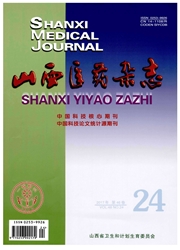

 中文摘要:
中文摘要:
目的探讨甲胎蛋白(alpha fetal protein,AFP)、血清总蛋白(total protein,TP)、白蛋白(albumin,ALB)以及超氧化物歧化酶(superoxide dismutase,SOD)在肝病患者中的变化及其临床意义。方法对200例符合纳入标准的肝病患者及50例正常对照组样本同时进行AFP、TP、ALB以及SOD的检测,对检测结果采用t检验和c2检验进行统计分析,比较4个指标在肝病患者与正常对照组间、肝病患者与肝癌患者间的差异以及其对肝病的检测敏感度。结果正常对照组与肝癌组及肝硬化组的AFP、TP、ALB、SOD检测结果相比,差异具有统计学意义(P〈0.05);而正常对照组与肝炎组的AFP、ALB、SOD检测结果比对显示差异有统计学意义(P〈0.05),TP检测结果显示差异无统计学意义(P〉0.05);对比分析肝癌组与肝硬化组检测结果显示,AFP、SOD差异有统计学意义(P〈0.05),TP、ALB检测结果显示差异无统计学意义(P〉0.05);对比分析肝癌组与肝炎组检测结果显示,AFP、ALB、SOD差异有统计学意义(P〈0.05),TP检测结果显示差异无统计学意义(P〉0.05);c2检验分析样本异常检出率可见3组中AFP、ALB、SOD异常检出率差异有统计学意义(P〈0.05);而TP阳性检出率3组间差异无统计学意义(P〉0.05)。结论肝病患者血清AFP、TP、ALB、SOD与健康者存在显著性差异,且随着病情的加重其异常检出率也随之增加,可作为指示肝病患者病情的检测指标。
 英文摘要:
英文摘要:
Objective To observe the change and clinical significance of AFP, TP, ALB, and SOD in hepatopathy patients. Methods AFP, TP, ALB, and SOD in 200 cases of hepatopathy patients who complied with experiment standards and 50 cases of healthy controls were detected simultaneously, T-test and the Chi-square test were used to compare the difference and detection sensitivities between cases and control group, respectively. Results The results showed that the difference of the plasma levels of AFP, TP, ALB and SOD in liver cancer and liver cirrhosis was statistically significant when compared with control group(P〈0.05); Significant differences existed in AFP, ALB and SOD in hepatitis compared with the control group(P〈0.05) while TP was no statistically significant difference between these two groups(P〈0.05); The statistical values revealed that there were significant correlation between liver cancer and liver cirrhosis with the plasma levels of AFP, and SOD(P〈0.05) while TP and ALB was not significantly different between these two groups(P〈0.05); Meanwhile, statistical significance was found in groups of liver cancer and hepatitis patients with the plasma levels of AFP, ALB and SOD(P〈0.05), instead, TP levels were not significantly different betweenthese two groups(P〈0.05); The abnormal detection rate of AFP, ALB and SOD was analyzed by c2 test and the result showed that there were statistically significant differences among the three groups(P〈0.05) and TP was the exact contrary(P〈0.05). Conclusion Compared hepatopathy patients groups with healthy controls, the plasma levels of AFP, TP, ALB and SOD have significant differences(P〈0.05); and the exception rate increased as the symptom became more serious, which can be used as an index that can respond to the condition of patients with liver disease.
 同期刊论文项目
同期刊论文项目
 同项目期刊论文
同项目期刊论文
 期刊信息
期刊信息
